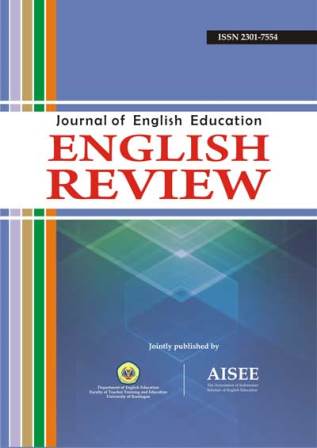LITERARY TEACHING AND ITS CONSTRAINTS: PARADIGMS AND PROBLEMS
Abstract
The paper will explore the nature of the literary teaching and its constraints. In language teaching, literary teaching has been promoted influential and approved effective to encourage the students’ character building in terms of some issues: historical, philosophical, cultural, social, and psychological contexts. Historically, literary teaching will provide students and learners of the ancients’ way of life and learn from the best in the past for their life experience. Some constraints may arise in language teaching due to the cultural and the philosophical boundaries. The constraints may be put into some categories; philosophical, cultural, social, and psychological. To generalize the idea, literary teaching needs efforts to boost the students’ skills to creatively launch themselves to a higher level of thinking order to achieve the goals of literary teaching and the demand of curriculum.
Keywords: literary teaching, humanity issues, constraints, critical thinking, competencyReferences
(2013) Literature in English: Teaching Syllabus 2013 Lower and Upper Secondary. Curriculum Planning and Development Division, Ministery of Education, Singapore
Abdullah, T, Zakaria, M.H, Ismail, F, Wan Mansor, Wan Fara A, Azis, M.A. (2007). A New Teaching Model to Teach Literature for the TESL Pre-Training Service Programme in Universiti Teknologi Malaysia (A Research). Malaysia: Jabatan Bahasa Moden Fakulti Pengurusan dan Pembangunan Sumber Manusia, Universiti Teknologi Malaysia
Buttler, I. (2006). “Integrating Language and Literature in English Studies: A Case Study of The English 100 Course at The University of North West†(A Ph.D Thesis in the Subject of English). The University of South Africa (unpublished).
Carter, R., & Long, M. (1991). Teaching Literature. Harlow, Essex: Longman
Carter, R., & McRae, J. (eds). (1996). Language, Literature and the Learner. Harlow: Addison Wesley, Longman
Cross, T.B, Dennis, K., & Isaacs, M. (1989). Towards a culturally competent system of care, volume I. Washington, D.C.: Georgetown University Child Development Center, CASSP Technical Assistance Center.
Cruz, J. H. R. (2010). The Role of Literature and Culture in English Language Teaching, Journal of Linguistica Aplicada, (7), available online: http://relinguistica.azc.uam.mx/no007/no07_art09.htm
De Riverol, J. E. (1991). Literature in the Teaching of English as a Foreign Language, in Revista Alicantina de Estudios Ingleses 4, pp: 65-69.
Hismanoglu, M. (2005). Teaching English through literature, Journal of Language and Linguistics Studies, 1(1), April 2005, pp. 53-66.
Iberri-Shea, G. (2009). Using public speaking tasks in English language teaching, English Teaching Forum, 47(2), pp. 18-36.
Khatib, M., Rezaei, S., & Derakhshan, A. (2011). Literature in EFL/ESL classroom, English Language Teaching, 4(1), March 2011, www.ccsenet.org/elt
Khatib, M., & Hossein, A. R. (2012). Literature and language teaching, Journal of Academic and Applied Studies, 2(6), pp. 32-38.
Lytovchenko, I. (2009). How to make upper-level university English classes more interactive, English Teaching Forum, 47(2), pp. 24-29.
Oscarson, A. D. (2009). Self-Assessment of Writing in English as a Foreign Language. Goteborg, Sweden: ACTA Universitatis Gothenborgensis. ERIC DRS ED505960.
Maley, A. (1989a). Down from the Pedestal: Literature as Resource. In R. Carter, R. Walker & C. Brumfit (eds), Literature and the Learner: Methodological Approaches. Modern English Publications and the British Counsel, pp. 1-9
McKay, S. (1982). Literature in the ESL Classroom, TESOL Quarterly 16(4), December 1982, pp. 529-536.
McRae, J. (1991). Literature with a Small “lâ€. London: Macmillan.
Meyers, C. (1986). Teaching Students to Think Critically (San Francisco: Jossey-Bass, 1986), p. 47.
Mujumdar, S. (2010). Teaching English language and literature in non-native context, Language in India: Strength for Today and Bright Hope for Tomorrow, 10, June 2010.
Savvidou, C. (2004). An integrated approach to teaching literature in the EFL classroom, The Internet TESL Journal, X(12), December 2004, published in http://iteslj.org/
Short, M. (1996). Exploring the Language of Poems, Plays and Prose. London: Longman.
Short, M. H. & Candlin, C. N. (1986). Teaching study skills for English literature. In C. J. Brumfit & R. A. Carter (Eds.), Literature and Language Teaching (pp. 89-109). Oxford: Oxford University Press.
Thomas, G. C., Batson, C. D. & Coke, Jay, S. (1981). Do good Samaritans discourage helpfulness?, Journal of Personality and Social Psychology, 40, pp. 194-200.
Tully, M. (2009). Mind mirror projects: A tool for integrating critical thinking into the English language classroom, English Teaching Forum, 47(1), pp. 10-17.
Wu, S. Y. (2008). Teaching the Three Little Pigs to EFL young learners in Taiwan, The Internet TESL Journal, XIV(1), January 2008
Yeasmin, N, Azad, Md. A.K, Ferdoush, J (2011). Teaching language through literature: Designing classroom activities. ASA University Review, 5(2), July-December 201, pp. 283-297
Zakian, M., Moradan, A., & Naghibi, S. E. (2012). The Relationship of Self-, Peer-, and Teacher Assessments in the Speaking of EFL Learners. ERIC DRS 530967.
All articles published in English Review: Journal of English Education (ERJEE) are licensed under the Creative Commons Attribution 4.0 International License (CC BY 4.0).
Copyright Ownership
Authors retain the copyright of their articles and grant ERJEE the right of first publication. The journal is granted a non-exclusive license to publish, reproduce, and distribute the article in any format, medium, or platform, provided that proper credit is given to the original authors.
License Terms – CC BY 4.0
Under the Creative Commons Attribution 4.0 International License, others are free to:
- Share — copy and redistribute the material in any medium or format
- Adapt — remix, transform, and build upon the material for any purpose, even commercially
As long as they:
- Provide appropriate credit to the original author(s) and source
- Provide a link to the license (https://creativecommons.org/licenses/by/4.0/)
- Indicate if any changes were made
There are no restrictions on the reuse, reproduction, or adaptation of published articles as long as attribution is properly given.
Author Warranties
By submitting a manuscript to ERJEE, authors confirm that:
- The work is original and does not infringe any existing copyright.
- The manuscript has not been previously published and is not under consideration elsewhere.
- All sources and references are appropriately acknowledged.
- Necessary permissions have been obtained for any copyrighted materials used.










